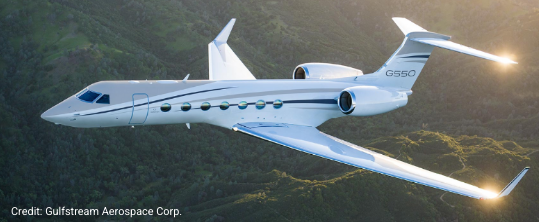Gulfstream G550
Aircraft Overview: Gulfstream G550

Gulfstream G550
Gulfstream’s G550 is a twin-engine business jet that is one of the commercial designations for the Savannah, Georgia-based manufacturer’s GV-SP type.
The airframe that eventually became the G550 made its first flight on July 18, 2002, with the original commercial designation being GV-SP (GV-Special Performance).
The change in commercial designation from GV-SP to G550 was revealed in September 2002, ahead of the GV-SP type receiving FAA approval on Aug. 14, 2003, and entering service that same year.
From a design perspective, the FAA type certificate data sheet (TCDS) notes that the GV-SP is “the same as” the company’s GV type, except for distinctions in the avionics, aerodynamics, cabin, and engines, as well as “operational changes for increased” economics, performance and range.
Although the final commercial G550 produced by Gulfstream was delivered in June 2021, deliveries of special-mission airframes to military customers have continued beyond that date.
Cabin
According to the FAA TCDS, the G550 can carry as many as 19 passengers, with those passengers accommodated in a cabin that has a length of 43 ft. 11 in.—"excluding baggage”—finished cabin height of 6 ft., finished cabin width of 7 ft. and volume of 1,669 ft.3
Despite that maximum passenger capacity, Gulfstream promoted the cabin as capable of providing sleeping accommodations for up to eight passengers, with the cabin space also able to be divided into as many as four living areas.
Configuration options included layouts with forward and aft galleys that incorporate a crew compartment, as well as another that has a forward galley but no crew compartment. The G550 also has 170 ft.3 of baggage compartment volume, while at 51,000 ft. the “feels like” cabin altitude is 6,000 ft.
In comparison to the Gulfstream’s GV type, the cabin changes made to the GV-SP type include the addition of a seventh pair of windows, the forward relocation of the main entry door, and “cabin improvements” that allowed for baggage space, comfort, and external visibility to be increased.
Avionics
Pilots operate the G550 using Gulfstream’s PlaneView flight deck that is based on Honeywell’s Primus Epic integrated avionics system, and which features four 14-in. liquid crystal displays (LCD) that were promoted as reducing the workload of the two required pilots.
Representing the “launch platform” for the PlaneView, authorized G550 pilots have the ability to “rely solely” on the standard enhanced flight vision system (EFVS) during landing, a capability that was marketed as improving the airplane’s “access to airports.”
Unlock the data behind the charts with Aviation Week Intelligence Network’s Fleet & Data Services. Learn more at aviationweek.com/bcaaircraftoverview.
For a comprehensive Program Profile including recent articles, program suppliers and current operators, please access via AWIN subscription here.
Variants
Powering the G550 are two BMW-Rolls-Royce Deutschland BR700-710C4-11 engines that use the BR710 commercial designation, and which have respective takeoff and maximum continuous static thrust limits of 15,385 lb. and 14,450 lb. at sea-level altitude and on a standard day.
In addition to the G550’s 91,000-lb. maximum takeoff weight (MTOW) and maximum landing weight of 75,300 lb., the basic operating weight is 48,300 lb. with four crew and “based on theoretical standard outfitting configurations.”
Also, assuming theoretical standard outfitting configurations, the maximum payload is 6,200 lb., a limit that is reduced to 1,800 lb. when carrying full fuel. With reference to the airplane’s fuel capacity, GV-SP airframes marketed as the G550 have a usable fuel capacity of 41,300 lb.
Mission and Performance
Operating limitations for the G550 include a maximum operating Mach number (MMO) of 0.885 Mach and a maximum operating altitude of 51,000 ft.
Beyond that airspeed limitation, Gulfstream also noted that the high-speed and long-range cruise speeds are 0.85 Mach and 0.80 Mach, respectively, while the airframe’s initial cruise altitude is 41,000 ft.
Based on the MTOW, sea-level altitude and International Standard Atmosphere (ISA) conditions, this GV-SP commercial designation has a takeoff distance of 5,910 ft.
The G550’s 6,750-nm theoretical maximum range assumes an airplane that is operated at the long-range cruise speed and with National Business Aviation Association (NBAA) instrument flight rules (IFR) reserves, in addition to carrying eight passengers and four crew.
Aviation Week Network is home to market-leading data and intelligence products. Find out which database is best for your business.
www.aircharterguide.com/
www.aircraftbluebook.com
www.acukwik.com/Products
www.airportdata.com
www.fleet.aviationweek.com